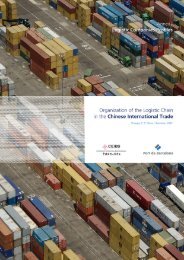Untitled - China Europe International Business School
Untitled - China Europe International Business School
Untitled - China Europe International Business School
You also want an ePaper? Increase the reach of your titles
YUMPU automatically turns print PDFs into web optimized ePapers that Google loves.
Organization of the logistic chain in the Chinese international trade<br />
Freight Forwarders<br />
Freight forwarders are reaching a global scope through alliances or consolidation through M&A,<br />
becoming able to provide international logistic services required by more and more globalized shippers<br />
and allowing them to negotiate with shipping lines at a global level.<br />
So far, Chinese forwarders cannot compete with international forwarders as long as they don’t have a<br />
well established overseas network. Forwarding companies without an international network can’t<br />
ambition global customers.<br />
Moreover, Chinese logistic companies seem to lack of expertise to organize sophisticated logistics for<br />
complex supply chains. A high turnover in management positions and shortage of qualified<br />
professionals makes logistics capabilities in Chinese logistic service providers still limited.<br />
Shipping Lines<br />
Shipping lines are increasingly becoming key players in the logistic chain. As they extend services and<br />
increase their market share through consolidation, they are becoming more decisive in the<br />
organization of the logistic chain.<br />
In order to cope with container cargo growth in the international trade worldwide and especially in the<br />
East-West trade, shipping lines are going through a range of measures. To ensure customers need for<br />
more space while reducing operating costs, shipping lines are incorporating new and bigger vessels<br />
and reducing direct calls to ports therefore increasing ports competition.<br />
Moreover, to escape the shortage of port capacity and land infrastructure in <strong>Europe</strong> which often leads<br />
to congestion, shipping lines are increasingly investing in Ports terminals. In an environment of high<br />
competition, the involvement in terminal operations allows shipping lines to control operating costs<br />
while increasing efficiency for their customers’ logistic chains. Some of the strategies are:<br />
– Investments in neighboring ports to escape congestion in main ports (for example, investing in<br />
Antwerp to avoid Rotterdam) or create a network of ports that allow to make-up for any incident<br />
or delay occurred in former stops.<br />
– Investments in ports where return-cargo is secured.<br />
On the other hand, existing strategic alliances between shipping lines are also providing many<br />
synergies as shared use of terminals, common operating of liner services, vessel space exchange, etc.<br />
Finally, as seen before, shipping lines through subsidiaries are also extending their scope, enlarging<br />
their services from port-to-port to door-to-door services to add value and differentiate from their<br />
competitors. However, shipping lines still need to rely on forwarders to accomplish inland<br />
transportation for a while.<br />
CEIBS Port of Barcelona Chair of Logistics 59










